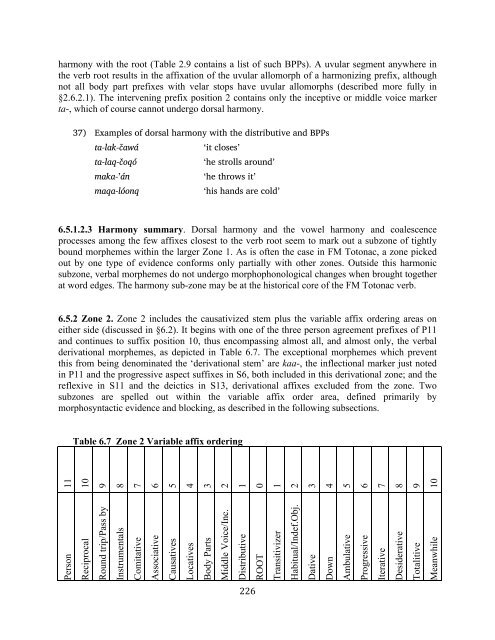The phonology and morphology of Filomeno Mata Totonac
The phonology and morphology of Filomeno Mata Totonac
The phonology and morphology of Filomeno Mata Totonac
Create successful ePaper yourself
Turn your PDF publications into a flip-book with our unique Google optimized e-Paper software.
harmony with the root (Table 2.9 contains a list <strong>of</strong> such BPPs). A uvular segment anywhere in<br />
the verb root results in the affixation <strong>of</strong> the uvular allomorph <strong>of</strong> a harmonizing prefix, although<br />
not all body part prefixes with velar stops have uvular allomorphs (described more fully in<br />
§2.6.2.1). <strong>The</strong> intervening prefix position 2 contains only the inceptive or middle voice marker<br />
ta-, which <strong>of</strong> course cannot undergo dorsal harmony.<br />
37) Examples <strong>of</strong> dorsal harmony with the distributive <strong>and</strong> BPPs<br />
ta-lak-c%awá ‘it closes’<br />
ta-laq-c%oqó ‘he strolls around’<br />
maka-’án ‘he throws it’<br />
maqa-lóonq ‘his h<strong>and</strong>s are cold’<br />
6.5.1.2.3 Harmony summary. Dorsal harmony <strong>and</strong> the vowel harmony <strong>and</strong> coalescence<br />
processes among the few affixes closest to the verb root seem to mark out a subzone <strong>of</strong> tightly<br />
bound morphemes within the larger Zone 1. As is <strong>of</strong>ten the case in FM <strong>Totonac</strong>, a zone picked<br />
out by one type <strong>of</strong> evidence conforms only partially with other zones. Outside this harmonic<br />
subzone, verbal morphemes do not undergo morphophonological changes when brought together<br />
at word edges. <strong>The</strong> harmony sub-zone may be at the historical core <strong>of</strong> the FM <strong>Totonac</strong> verb.<br />
6.5.2 Zone 2. Zone 2 includes the causativized stem plus the variable affix ordering areas on<br />
either side (discussed in §6.2). It begins with one <strong>of</strong> the three person agreement prefixes <strong>of</strong> P11<br />
<strong>and</strong> continues to suffix position 10, thus encompassing almost all, <strong>and</strong> almost only, the verbal<br />
derivational morphemes, as depicted in Table 6.7. <strong>The</strong> exceptional morphemes which prevent<br />
this from being denominated the ‘derivational stem’ are kaa-, the inflectional marker just noted<br />
in P11 <strong>and</strong> the progressive aspect suffixes in S6, both included in this derivational zone; <strong>and</strong> the<br />
reflexive in S11 <strong>and</strong> the deictics in S13, derivational affixes excluded from the zone. Two<br />
subzones are spelled out within the variable affix order area, defined primarily by<br />
morphosyntactic evidence <strong>and</strong> blocking, as described in the following subsections.<br />
11<br />
Person<br />
Table 6.7 Zone 2 Variable affix ordering<br />
10<br />
Reciprocal<br />
9<br />
Round trip/Pass by<br />
8<br />
Instrumentals<br />
7<br />
Comitative<br />
6<br />
Associative<br />
5<br />
Causatives<br />
4<br />
Locatives<br />
3<br />
Body Parts<br />
2<br />
1<br />
! ##*!<br />
0<br />
Middle Voice/Inc.<br />
VVVoVoiceVoice/In<br />
Distributive<br />
choative<br />
ROOT<br />
1<br />
Transitivizer<br />
2<br />
3<br />
Habitual/Indef.Obj.<br />
Object<br />
Dative<br />
4<br />
Down<br />
5<br />
Ambulative<br />
6<br />
Progressive<br />
7<br />
Iterative<br />
8<br />
Desiderative<br />
9<br />
Totalitive<br />
10<br />
Meanwhile

















